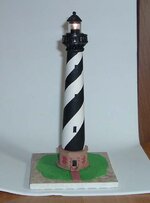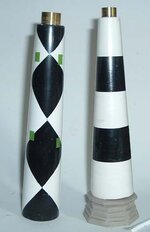Dale Allen
Member
Someone at work got me interested in the Cape Hatteras lighthouse so after reading up on it I decide to try this.
There are brass tubes in the column center, a small plastic tube for the lens and a mini flashlight in the tube to make it light.
Looks even better in a dark room.
All the rest is polymer clay.
There are 2 others from that area of the coast that I may build.
There are brass tubes in the column center, a small plastic tube for the lens and a mini flashlight in the tube to make it light.
Looks even better in a dark room.
All the rest is polymer clay.
There are 2 others from that area of the coast that I may build.


